What’s the Best Mattress for Kids?
The Helix Kids mattress nabbed the top spot in this roundup because of its flippable design, water-repellent finish, and fiberglass-free fire barrier. Its hybrid construction combines a 6-inch spring unit with an initial foam layer on each side, resulting in an optimal balance of support and comfort for growing children.
Best Mattresses for Kids
Our Video Review of The Best Beds for Kids

Compare the Best Beds for Kids
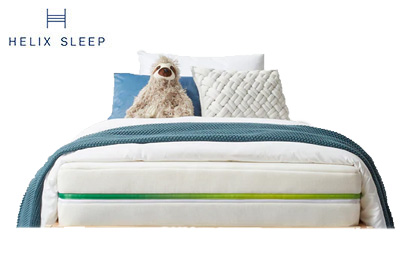
|
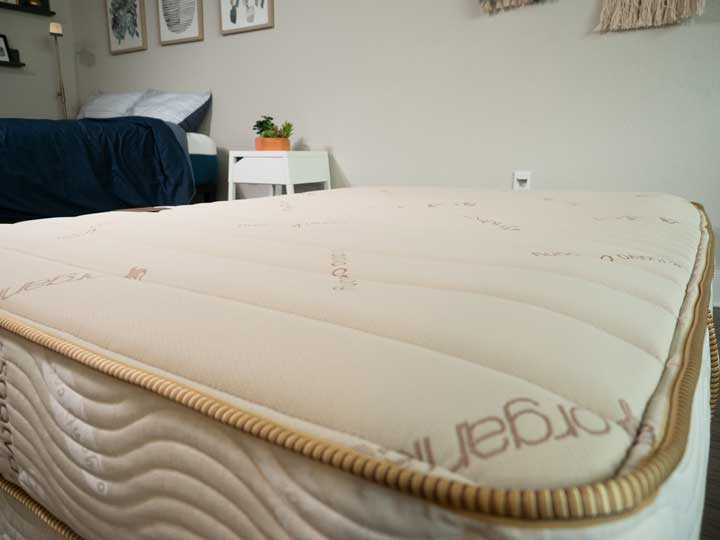
|
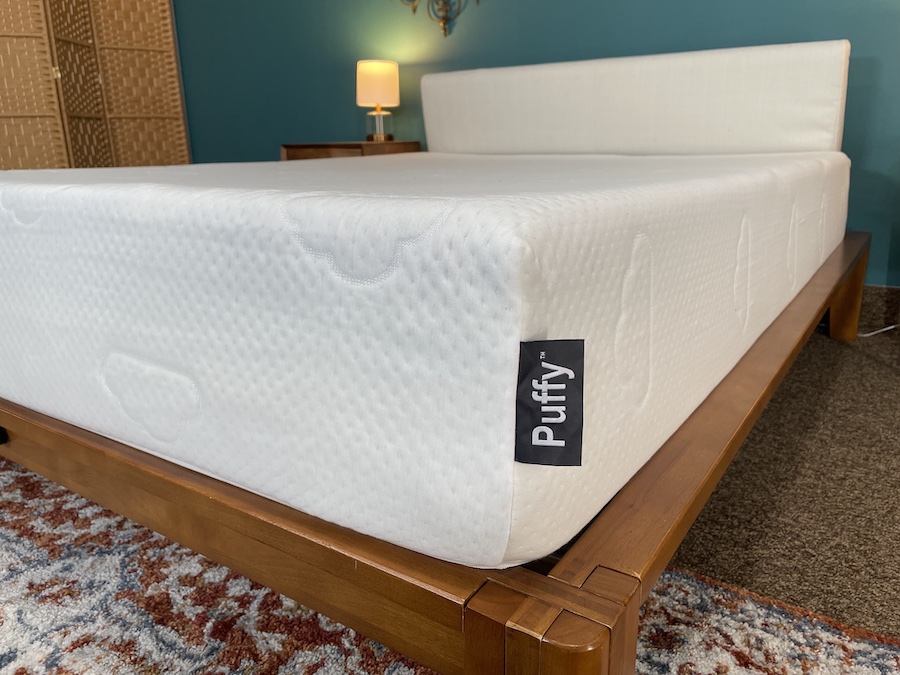
|
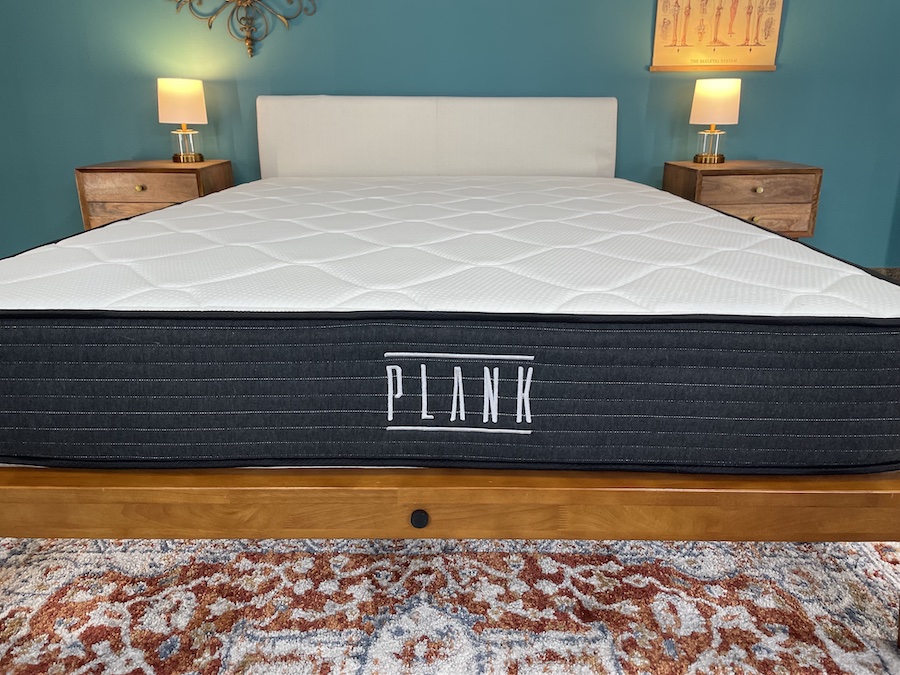
|
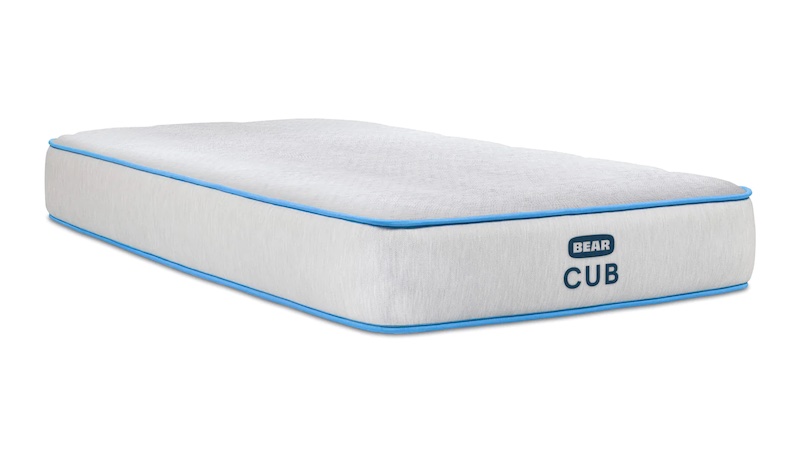
|

|
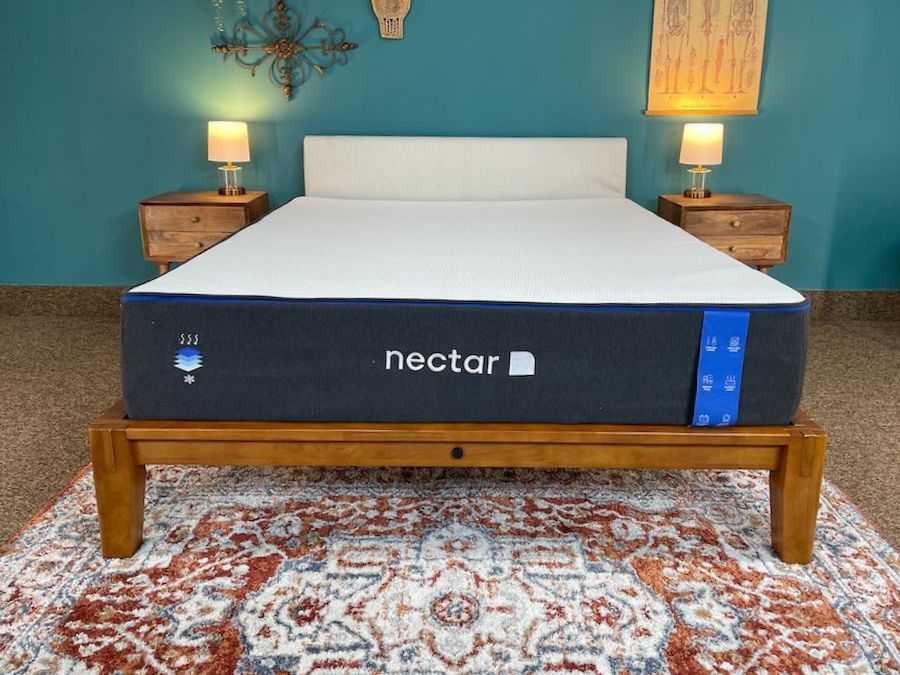
|
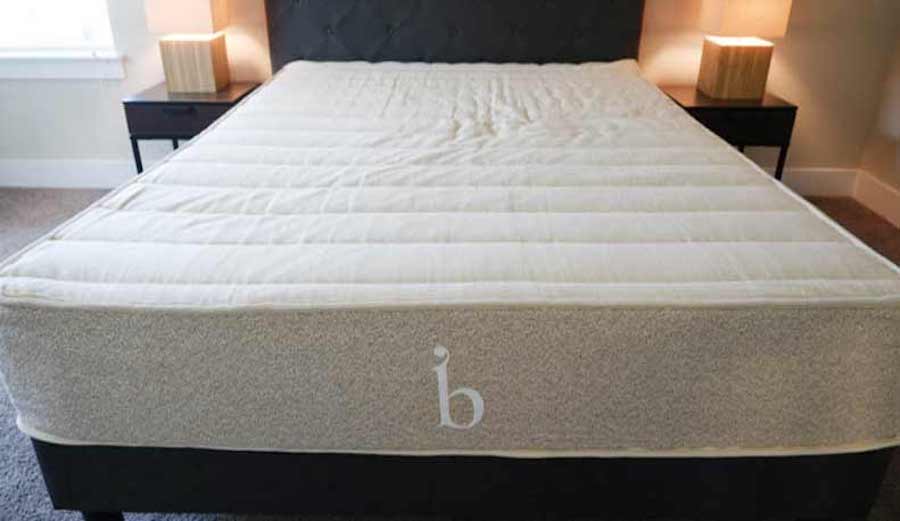
|
|
| Helix Kids Mattress | Saatva Youth Mattress | Puffy Cloud Mattress | Brooklyn Bedding Plank Firm Mattress | Bear Cub | Brooklyn Bedding Essential | Nectar Mattress | Birch Natural Mattress | |
| Rating | ||||||||
| Firmness | Medium-firm: 6.5/10 | Medium-firm: 6.5/10 | Multiple firmness options | Medium-firm: 6.5/10 | Medium-firm: 6.5/10 | |||
| Material | Hybrid | Innerspring | Foam | Foam | Hybrid | Hybrid | Foam | Hybrid |
| Cooling |
|
|
— | — | — |
|
— |
|
| Warranty | 10-year warranty | Lifetime warranty | Lifetime warranty | 10-year warranty | Lifetime warranty | 10-year warranty | Lifetime warranty | 25-year warranty |
| Shipping | Free shipping | Free white glove delivery | Free shipping | Free shipping | Free shipping minus HI and AK | Free shipping | Free shipping | Free shipping |
| Trial Period | 100 Nights | 365 nights | 101 nights | 120 nights | 120 nights | 120 nights | 365 nights | 100 nights |
| Best For | Side Sleepers, Back Sleepers, Stomach Sleepers, Kids, Hot Sleepers | Kids, Hot Sleepers, Back Sleepers, Stomach Sleepers | Side Sleepers, Back Sleepers, Back Pain, Kids | Stomach Sleepers, Back Pain | Kids | Back Sleepers, Side Sleepers, Hot Sleepers | Back Sleepers, Side Sleepers, Hip Pain, Joint Pain | Back Sleepers, Stomach Sleepers, Hot Sleepers |
How Did We Choose the Best Mattresses for Kids?
Although I’m no longer a kid myself, I have a lot of mattress testing experience and an eye for a well-constructed bed.
For this roundup, I collected mattresses that met key requirements for a child’s restful sleep, including a medium-firm feel, durable materials, and reassuring certifications that attest to a bed’s safety and overall quality.
The beds I’ve highlighted are intended for kids between the ages of 3 and 12. They often function as a child’s first “big-kid bed,” and their designs foster rest and support throughout these years of growth.
Read our full product testing methodology to learn more about how we review the mattresses we feature.
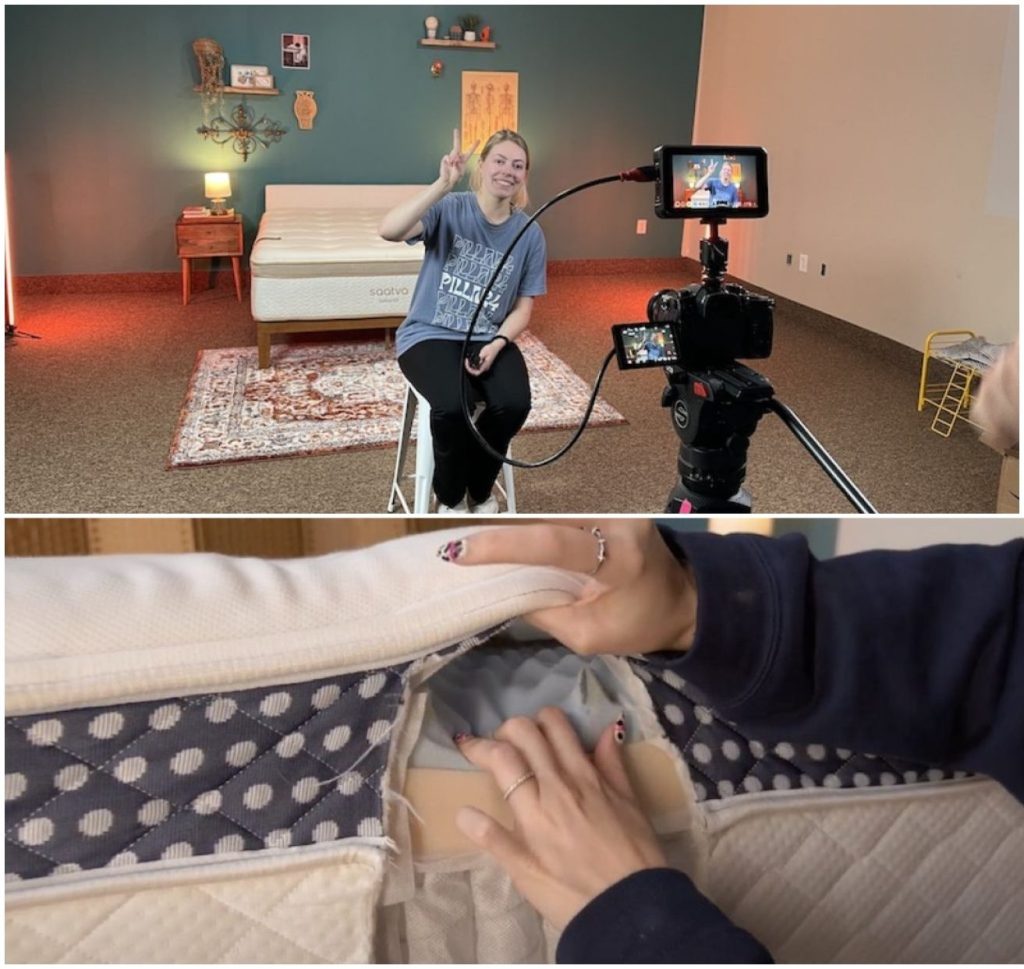
What We Want to See in a Kids’ Mattress
Enough Firmness and Support
A mattress for children should have a medium-firm (or firm) feel coupled with a strong support system. These aspects encourage a neutral spinal alignment—an important concern for skeletal systems that are still developing.
As such, every mattress on this list received either a 4 out of 5 or a perfect 5 out of 5 in the “Support” category during our testing.
The Ability to Withstand Messes
Kids can be rough on their mattresses, whether they’re jumping on the bed or undergoing potty training. A good children’s mattress will stand up to this treatment with strong components and an easy-to-clean or moisture-resistant surface.
Adaptability as Kids Age
As children grow, their sleep needs shift. A good kids’ mattress accommodates their development with a design that’s adaptable enough to suit different age ranges. Some children’s beds on this list have two usable sides designated for different life stages; others can accommodate both children and adults.
The Best Kids’ Mattresses, Reviewed
Helix Kids – Editor’s Pick
Helix Kids Mattress
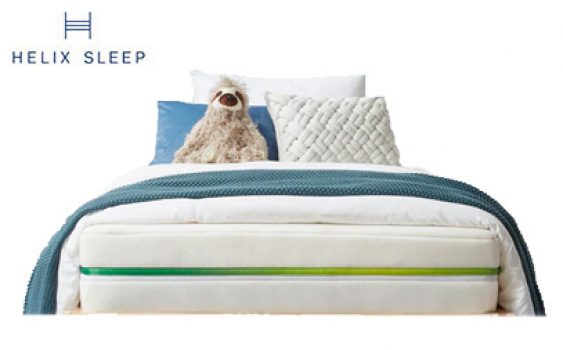
Designed specifically for kids, this Helix bed features a flippable design and dual firmness levels
Material
Hybrid
Trial Period
100 Nights
Shipping Method
Free shipping
Firmness
Multiple firmness options
Warranty
10-year warranty
Price Range
$$$$$
We recommend this mattress for the following sleeper types:
Hot Sleepers
If you often overheat while you sleep, this mattress should help you stay cool.Kids
This bed is perfect for young sleepers.Back Sleeping
Ideal for lightweight back sleepers.Side Sleeping
Ideal for lightweight side sleepers.Stomach Sleeping
Ideal for lightweight stomach sleepers.Financing Options
Financing options are available for this mattress.
Helix Kids Mattress

Designed specifically for kids, this Helix bed features a flippable design and dual firmness levels
Material
Hybrid
Warranty
10-year warranty
Firmness
Multiple firmness options
Shipping Method
Free shipping
Trial Period
100 Nights
Price Range
$$$$$
We recommend this mattress for the following sleeper types:
Hot Sleepers
If you often overheat while you sleep, this mattress should help you stay cool.Kids
This bed is perfect for young sleepers.Back Sleeping
Ideal for lightweight back sleepers.Side Sleeping
Ideal for lightweight side sleepers.Stomach Sleeping
Ideal for lightweight stomach sleepers.Financing Options
Financing options are available for this mattress.

Helix Kids Mattress
Designed specifically for kids, this Helix bed features a flippable design and dual firmness levels
Material
Hybrid
Firmness
Multiple firmness options
Trial Period
100 Nights
Warranty
10-year warranty
Shipping Method
Free shipping
Price Range
$$$$$
We recommend this mattress for the following sleeper types:
Hot Sleepers
If you often overheat while you sleep, this mattress should help you stay cool.Kids
This bed is perfect for young sleepers.Back Sleeping
Ideal for lightweight back sleepers.Side Sleeping
Ideal for lightweight side sleepers.Stomach Sleeping
Ideal for lightweight stomach sleepers.Financing Options
Financing options are available for this mattress.
Why the Helix Kids Earned Best Mattress for Kids Overall
With two usable sides—each one meant for a different age range—the Helix Kids mattress banishes the stress of buying a new bed for your kid every few years. Its design enables its firmness to change alongside a child’s growth.
The firmer side, which is recommended for children ages 3-7, has a more robust feel that prioritizes support. The softer side, which is for ages 8-12, should satisfy older kids who’ve developed a preference for a more pillowy surface. A host of child-friendly certifications and protective treatments round out the reasons why I chose this bed as the best mattress for kids.
What’s the Helix Kids Made Of
The Helix Kids mattress is 8 inches tall and has seven total layers in its flippable design.
- Layer 1 – Tencel™ Cover. Both sides of the mattress have a hypoallergenic Tencel™ cover that’s been treated to prevent damage from spills and infiltration from germs.
- Layer 2 – Fire Safety Layer. A fiberglass-free fabric blend for fire resistance.
- Layer 3 – Helix Responsive Foam. A dense foam that promotes healthy body alignment in younger children.
- Layer 4 – Coils. Individually wrapped coils with reinforced springs on the long sides.
- Layer 5 – Gel Memory Foam. This foam gives the softer side of the bed a cradling, cozy feel.
- Layer 6 – Fire Safety Layer. A second fire-resistant layer.
- Layer 7 – Tencel™ Cover. The same Tencel™ cover, just on the softer side.
Our Take: Helix is known for making mattresses that cater to specific types of sleepers, and their children’s bed follows this pattern of precision. The care that went into its design is reflected in its longevity—if you opt for this model, you may not have to get another bed for your child until they’re a teen.
What We Liked
- Highly certified and safe – The Helix Kids holds certifications from GREENGUARD Gold and CertiPUR-US® that speak to the quality of its materials. Lead and phthalate testing, fiberglass-free fire barriers, and an antimicrobial treatment on the cover all add to the bed’s safety credentials.
- Resists stains and spills – Thanks to a plant-based finish, the surface of this bed repels water and doesn’t stain as easily as an adult mattress might.
Potential Drawbacks
- Only two sizes – A limited range of sizes is common for kids’ mattresses, but Helix doesn’t offer a twin XL version—just twin and full models.
- Very springy – The springs take up 6 inches of the bed’s 8-inch height, giving it a lot of bounce and responsiveness. Some kids love this quality, but others may want a mattress with a bit more softness and sink when they get older.
Customer Reviews of The Helix Kids Mattress
On the Helix website, this mattress is rated 4.3 out of 5 stars. The Helix Kids mattress provides customizable comfort for young children, but some customers may find the initial setup process slightly complex.
Want to know more? Read our in-depth Helix Kids mattress review or check out our best mattresses of 2024 page.
Saatva Youth – Best Innerspring Mattress for Kids
Saatva Youth Mattress
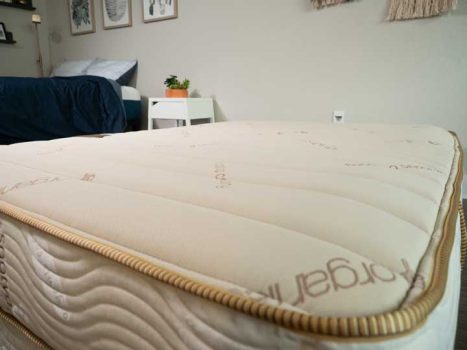
A dual-sided kids’ mattress that’s designed to see children through the ages of 3 to 12.
Material
Innerspring
Trial Period
365 nights
Shipping Method
Free white glove delivery
Firmness
Medium-firm: 6.5/10
Warranty
Lifetime warranty
Price Range
$$$$$
We recommend this mattress for the following sleeper types:
Hot Sleepers
If you often overheat while you sleep, this mattress should help you stay cool.Kids
This bed is perfect for young sleepers.Back Sleeping
Ideal for lightweight back sleepers.Stomach Sleeping
Ideal for lightweight stomach sleepers.Financing Options
Financing options are available for this mattress.
Saatva Youth Mattress

A dual-sided kids’ mattress that’s designed to see children through the ages of 3 to 12.
Material
Innerspring
Warranty
Lifetime warranty
Firmness
Medium-firm: 6.5/10
Shipping Method
Free white glove delivery
Trial Period
365 nights
Price Range
$$$$$
We recommend this mattress for the following sleeper types:
Hot Sleepers
If you often overheat while you sleep, this mattress should help you stay cool.Kids
This bed is perfect for young sleepers.Back Sleeping
Ideal for lightweight back sleepers.Stomach Sleeping
Ideal for lightweight stomach sleepers.Financing Options
Financing options are available for this mattress.

Saatva Youth Mattress
A dual-sided kids’ mattress that’s designed to see children through the ages of 3 to 12.
Material
Innerspring
Firmness
Medium-firm: 6.5/10
Trial Period
365 nights
Warranty
Lifetime warranty
Shipping Method
Free white glove delivery
Price Range
$$$$$
We recommend this mattress for the following sleeper types:
Hot Sleepers
If you often overheat while you sleep, this mattress should help you stay cool.Kids
This bed is perfect for young sleepers.Back Sleeping
Ideal for lightweight back sleepers.Stomach Sleeping
Ideal for lightweight stomach sleepers.Financing Options
Financing options are available for this mattress.
Why the Saatva Youth Earned Best Innerspring Mattress for Kids
Saatva’s standout innerspring beds have long since proven their mettle in the adult world, especially when it comes to addressing back pain. It’s no surprise, then, that the Saatva Youth preserves some of these spine-focused features: firmer quilting in the cover, zoned foam, and even a Lumbar Zone® Active Spinal Wire all shore up support beneath the lower back in this children’s bed.
What’s more, the Saatva Youth is flippable. One side addresses the needs of children ages 3-7, while the other focuses on ages 8-12. Regardless of your child’s age, they’ll be benefiting from eco-friendly components such as an organic cotton cover and a thistle-based natural flame barrier.
What’s the Saatva Youth Made Of?
The Saatva Youth mattress is 10 inches tall and has five distinct layers, plus foam rails around the perimeter for enhanced edge support.
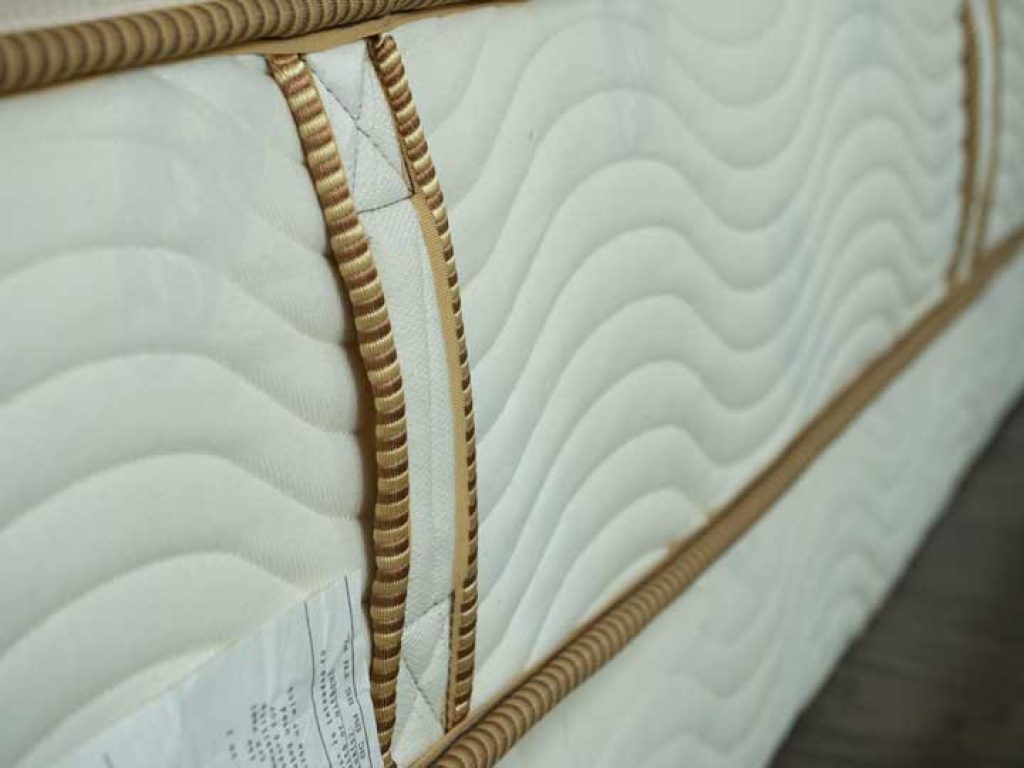
- Layer 1 – Organic Cotton Cover. Breathable organic cotton helps the cover to stay cool, while a water-resistant finish and antimicrobial treatment guard against spills and bacteria. The cover is even quilted to feel firmer in the middle third, right underneath the sensitive lumbar spine.
- Layer 2 – Zoned Foam Support Layer. A sheet of foam with additional lumbar support in the center.
- Layer 3 – Coils. Interconnected coils made of recycled steel form the primary support layer of the mattress. On the side meant for older children, a Lumbar Zone® Active Spinal Wire also bolsters the area beneath the lower back.
- Layer 4 – High-Density Comfort Foam. A textured foam that allows for both cooling and a bit of comfortable sinkage.
- Layer 5 – Organic Cotton Cover. A mirror image of the cover on the other side.
Our Take: This is one of the fanciest children’s mattresses we’ve encountered, with a laundry list of special features and a thicker profile than many other beds on this list. Saatva knows its springs, so you can be confident that this mattress will hold up as your child grows (and jumps on it occasionally).
What We Liked
- Especially waterproof – Not only does the Saatva Youth have a water-resistant finish on its cover, but on the side meant for younger children, it also has a waterproof barrier inside the upper layers of the mattress itself.
- White glove delivery – Saatva’s team handles all aspects of delivery and placement when your mattress arrives. They can even remove your old bed for you, too.
Potential Drawbacks
- Deals aren’t as frequent – Due to its high-quality construction, the Saatva Youth is a relatively expensive children’s mattress, and sales aren’t as common or dramatic on this site as they are on many competitors’.
- Not compatible with all bunk-bed frames – The Saatva Youth is 10 inches thick, which makes it a bit loftier than typical mattresses used for bunk beds. Be sure to measure your bed frame and guard rails carefully if you intend to use this mattress in a bunk-bed setup.
Customer Reviews of The Saatva Youth Mattress
On the Saatva website, this mattress is rated 5 out of 5 stars. The Saatva Youth mattress offers excellent durability and support for young customers; however, some customers may find it relatively expensive compared to other youth mattresses on the market.
Need more details? See our full Saatva Youth mattress review or explore the top picks for the best innerspring mattresses.
Puffy Cloud – Best Medium-Firm Mattress for Kids
Puffy Cloud Mattress
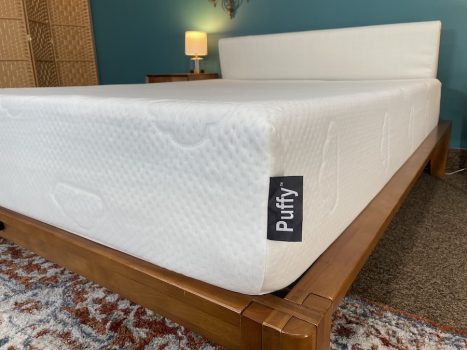
Puffy provides a classic memory foam feel with enhanced pressure relief that should appeal to most sleepers.
Material
Foam
Trial Period
101 nights
Shipping Method
Free shipping
Firmness
Medium-firm: 6.5/10
Warranty
Lifetime warranty
Price Range
$$$$$
We recommend this mattress for the following sleeper types:
Kids
This bed is perfect for young sleepers.Back Pain
This bed is perfect for anyone suffering from back pain.Back Sleeping
Ideal for lightweight and average weight back sleepers.Side Sleeping
Ideal for lightweight and average weight side sleepers.Financing Options
Financing options are available for this mattress.
Puffy Cloud Mattress

Puffy provides a classic memory foam feel with enhanced pressure relief that should appeal to most sleepers.
Material
Foam
Warranty
Lifetime warranty
Firmness
Medium-firm: 6.5/10
Shipping Method
Free shipping
Trial Period
101 nights
Price Range
$$$$$
We recommend this mattress for the following sleeper types:
Kids
This bed is perfect for young sleepers.Back Pain
This bed is perfect for anyone suffering from back pain.Back Sleeping
Ideal for lightweight and average weight back sleepers.Side Sleeping
Ideal for lightweight and average weight side sleepers.Financing Options
Financing options are available for this mattress.

Puffy Cloud Mattress
Puffy provides a classic memory foam feel with enhanced pressure relief that should appeal to most sleepers.
Material
Foam
Firmness
Medium-firm: 6.5/10
Trial Period
101 nights
Warranty
Lifetime warranty
Shipping Method
Free shipping
Price Range
$$$$$
We recommend this mattress for the following sleeper types:
Kids
This bed is perfect for young sleepers.Back Pain
This bed is perfect for anyone suffering from back pain.Back Sleeping
Ideal for lightweight and average weight back sleepers.Side Sleeping
Ideal for lightweight and average weight side sleepers.Financing Options
Financing options are available for this mattress.
Why the Puffy Cloud Earned Best Medium-Firm Mattress for Kids
When I tested the Puffy Cloud, I thought its all-foam design would be a great fit for lightweight and average-weight folks. I’ve since realized that it could be an awesome bed for kids, too! It has a medium-firm feel that balances essential support with initial coziness, a washable cover, and even a cute cloud design on the cover that seems like it would charm younger sleepers.
What’s the Puffy Cloud Made Of?
The Puffy Cloud is 10 inches tall and contains five layers (if you count its top and bottom covers).
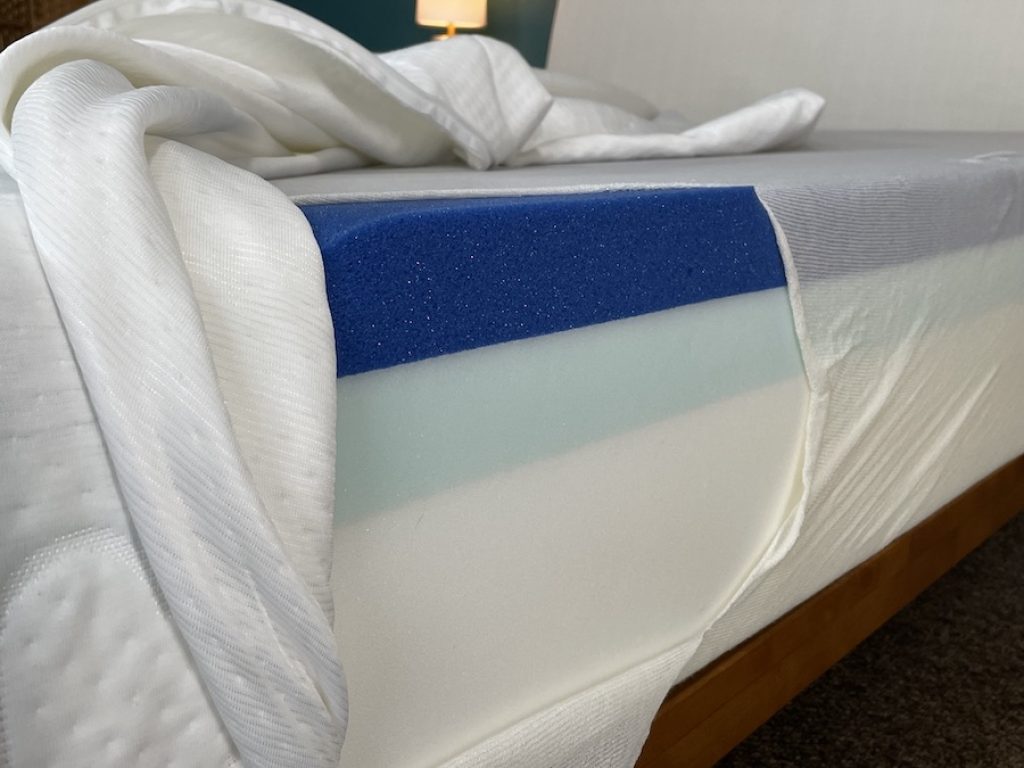
- Layer 1 – Cover. A hypoallergenic top cover that can be unzipped and removed for deep cleaning as needed.
- Layer 2 – Cooling Cloud™ Foam (2 inches). Gel-infused foam that’s engineered to prevent heat buildup while cradling your body.
- Layer 3 – Climate Comfort™ Foam (2 inches). Another foam with temperature-regulating properties. This one resists humidity and allows for increased airflow throughout the bed.
- Layer 4 – Firm Core Support Foam (6 inches). The bed’s supportive, high-density foam base.
- Layer 5 – Base Cover. A textured, anti-slip bottom cover.
My Take: Even though it’s not a super-soft bed, I enjoy how it feels around my hips and shoulders. It’s most definitely on the supportive side, but not at all rigid or allowing tension to build up. Its responsiveness and spine-aligning abilities are also solid.
What I Liked
- Good for backs, young and old – The Puffy Cloud has received an endorsement from the American Chiropractic Association for its ability to keep the back and spine in proper position. As your kid is growing, encouraging good spinal alignment can be especially useful.
- Pressure relief without too much sink – The surface of the Cloud feels appropriately cloud-like, but there’s no denying that this all-foam bed has a strong, sturdy base. Kids need a lot of support from their bed as they develop, and this one has a good amount.
Potential Drawbacks
- Weak edges – I described the edge support on the Puffy Cloud as a bit “meh.” This isn’t the most important aspect of a children’s mattress, but if your kid tends to roll to the side of the bed while sleeping, it may prove relevant.
- Foams aren’t super cool – These foams advertise a lot of cooling abilities, but I didn’t think the Puffy Cloud came off as a particularly chilled-out mattress. A latex or hybrid bed will likely feel cooler.
Customer Reviews of The Puffy Cloud Mattress
The Puffy Cloud rates 4.9 out of 5 on Puffy’s website. Customers often praise the Puffy Cloud mattress for its plush comfort and excellent motion isolation, but some have mentioned it might be too soft for those who prefer a firmer feel.
Want to know more? Read our Puffy mattress review or explore our top picks for the best medium-firm mattresses.
Plank Firm – Best Firm Mattress for Kids
Brooklyn Bedding Plank Firm Mattress
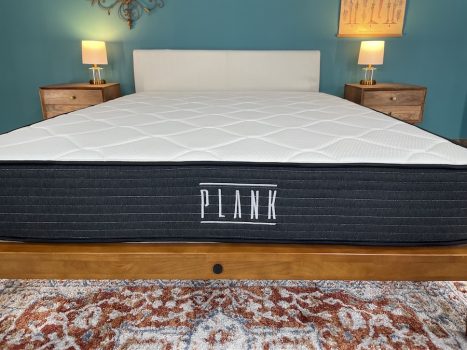
Those in the market for a Firm bed now have a dual-sided choice to see what they require to sleep well-supported and comfortable in Plank Firm, a new product from Brooklyn Bedding.
Material
Foam
Trial Period
120 nights
Shipping Method
Free shipping
Firmness
Multiple firmness options
Warranty
10-year warranty
Price Range
$$$$$
Brooklyn Bedding Plank Firm Mattress

Those in the market for a Firm bed now have a dual-sided choice to see what they require to sleep well-supported and comfortable in Plank Firm, a new product from Brooklyn Bedding.
Material
Foam
Warranty
10-year warranty
Firmness
Multiple firmness options
Shipping Method
Free shipping
Trial Period
120 nights
Price Range
$$$$$

Brooklyn Bedding Plank Firm Mattress
Those in the market for a Firm bed now have a dual-sided choice to see what they require to sleep well-supported and comfortable in Plank Firm, a new product from Brooklyn Bedding.
Material
Foam
Firmness
Multiple firmness options
Trial Period
120 nights
Warranty
10-year warranty
Shipping Method
Free shipping
Price Range
$$$$$
Why the Plank Firm Earned Best Firm Mattress for Kids
Kids need a stable, highly supportive mattress that won’t dip or sag as they grow. The Plank Firm is one of the most reliable beds out there in terms of staying sturdy—it’s a flat, firm mattress that mimics the feel of Asian sleeping mats.
Having tested the Plank personally, I recommend it for folks who don’t like a ton of cushion and who need even-keel alignment, night after night. Its flippable design does give it some versatility: one side is extremely firm, and the other has a more traditionally firm feel.
What’s the Plank Firm Made Of?
The Plank Firm is an all-foam mattress with four layers and a 10.25-inch height. It’s flippable, with a firm side and an extra-firm side.
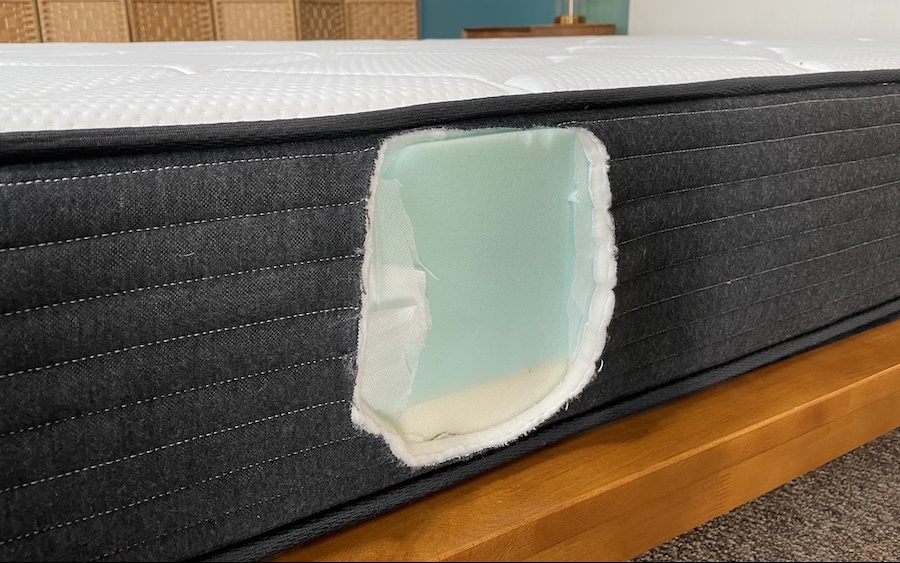
- Layer 1 – Quilted Top, Extra-Firm Side (0.75 inches). A quilted surface with no cushion or loft.
- Layer 2 – High-Density Support Foam (6 inches). This core of firm foam makes up the bulk of the mattress.
- Layer 3 – TitanFlex™ Comfort Foam (2 inches). A responsive, latex-like foam that gives the less firm side a smidge of give.
- Layer 4 – Quilted Top, Firm Side (1.5 inches). A quilted surface with a small amount of loft.
My Take: It doesn’t get more solid than the Plank. If you want consistent, bracing support and spine-aligning stability in your kid’s mattress, it will deliver. But be aware that it’s truly, truly firm, and some children may not love the lack of cushion.
What I Liked
- Keeps stomach sleepers lifted – I’m a stomach sleeper myself, and it’s hard to find beds that accommodate this position without a lot of sinking around the hips and lower back. Thankfully, the Plank kept my spine aligned while I lied on both my stomach and my back.
- Flip to change the feel – With a mattress as seemingly uncompromising as the Plank, it’s lovely to be able to access two different firmnesses: an ultra-firm one, and a slightly less firm one. Flipping the bed is relatively simple (though kids should not attempt it without an adult’s help!).
Potential Drawbacks
- Extremely firm – This bed is really, really firm—so much so that it might be uncomfortable for exclusive side sleepers or anyone who desires a pillowy feel from their mattress.
- Cooling cover costs extra – You can add a GlacioTex™ cooling cover to both sides of the Plank Firm, but it will cost you an additional fee at checkout. Otherwise, be prepared for some heat buildup with this all-foam bed.
Customer Reviews of The Plank Firm
On Plank’s website, the Plank Firm gets 4.8 out of 5 stars. Customers appreciate the Brooklyn Bedding Plank Firm mattress for its exceptional firmness, but some have found it to be too rigid for their comfort preferences.
Want to know more? Check out our full Plank Firm mattress review or check out our best firm mattress options.
Bear Cub – Best Hybrid Mattress for Kids
Bear Cub
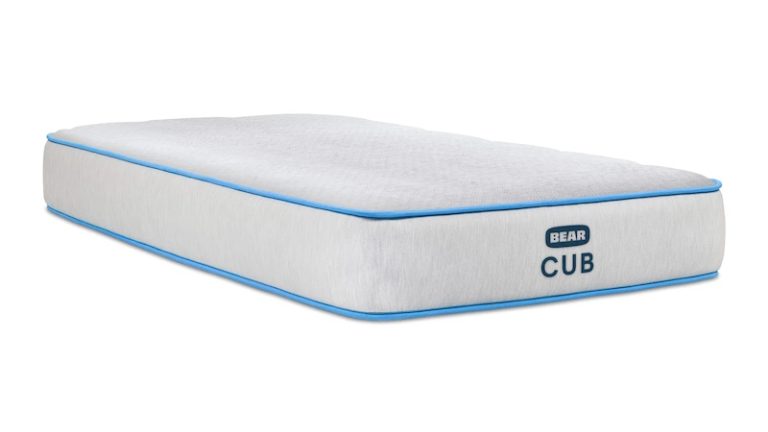
A hybrid mattress designed especially for children, the Bear Cub holds multiple safety certifications and even offers a choice between two colors for its border fabric.
Read Bear Cub ReviewMaterial
Hybrid
Trial Period
120 nights
Shipping Method
Free shipping minus HI and AK
Firmness
Warranty
Lifetime warranty
Price Range
$$$$$
Bear Cub

A hybrid mattress designed especially for children, the Bear Cub holds multiple safety certifications and even offers a choice between two colors for its border fabric.
Read Bear Cub ReviewMaterial
Hybrid
Warranty
Lifetime warranty
Firmness
Shipping Method
Free shipping minus HI and AK
Trial Period
120 nights
Price Range
$$$$$

Bear Cub
A hybrid mattress designed especially for children, the Bear Cub holds multiple safety certifications and even offers a choice between two colors for its border fabric.
Read Bear Cub ReviewMaterial
Hybrid
Firmness
Trial Period
120 nights
Warranty
Lifetime warranty
Shipping Method
Free shipping minus HI and AK
Price Range
$$$$$
Why the Bear Cub Earned Best Hybrid Mattress for Kids
A hybrid bed is built with both springs and comfort layers, so it strikes a great balance between support, responsiveness, and cushion in a kids’ mattress. The cutely named Bear Cub is an exemplary hybrid mattress for children, as it also boasts impressive safety certifications and a hypoallergenic cover.
A GREENGUARD Gold certification attests that the Bear Cub meets strict standards for low emissions, and its foams are also CertiPUR-US® certified, meaning they don’t contain several potentially harmful ingredients.
What’s the Bear Cub Made Of?
The Bear Cub is 8.5 inches tall and has four total layers.
- Layer 1 – Tencel™ Cover. A hypoallergenic, breathable cover.
- Layer 2 – Gel Memory Foam. Cradling memory foam that’s been infused with gel for better cooling.
- Layer 3 – Responsive Foam. A firmer foam that helps with spinal alignment and bounces back into shape quickly.
- Layer 4 – Coils. Individually wrapped springs that have been reinforced along the edges of the bed.
Our Take: Bear makes mattresses geared toward active adults, so their children’s mattress should be a good fit for kids and all their hyperactivity. It’s springy, supportive, and fiberglass-free for peace of mind.
What We Liked
- Edge support comes standard – Not all mattresses for kids have reinforced edges, so we take note of edge support where we can find it. The Bear Cub should work well for children who tend to roll toward or sleep on the sides of their bed.
- Color options – For a fun bit of customization, you can choose between Arctic Blue or Salmon as the color of the border fabric on your Bear Cub.
Potential Drawbacks
- No waterproofing – Some children’s mattresses contain water-resistant or waterproof layers to stave off damage from spills and accidents. The Bear Cub doesn’t have this feature.
- Weight limit – Bear advises that this bed is meant for kids who weigh no more than 150 pounds.
Customer Reviews of the Bear Cub
On Bear’s website, the Bear Cub has an average score of about 4.2 out of 5 stars. Although its hybrid construction may make it feel a bit too firm for lightweight kids, many parents comment that it’s comfortable and supportive—enough for them to nap on it, too.
Want to see more hybrids? Peruse our list of the best hybrid mattresses.
Brooklyn Bedding Brooklyn Essential – Best Affordable Mattress for Kids
Brooklyn Bedding Essential

The Brooklyn Essential is an impressively affordable hybrid with a simple yet satisfying construction.
Material
Hybrid
Trial Period
120 nights
Shipping Method
Free shipping
Firmness
Medium-firm: 6.5/10
Warranty
10-year warranty
Price Range
$$$$$
We recommend this mattress for the following sleeper types:
Hot Sleepers
If you often overheat while you sleep, this mattress should help you stay cool.Back Sleeping
Ideal for lightweight and average weight back sleepers.Side Sleeping
Ideal for lightweight and average weight side sleepers.Financing Options
Financing options are available for this mattress.
Brooklyn Bedding Essential

The Brooklyn Essential is an impressively affordable hybrid with a simple yet satisfying construction.
Material
Hybrid
Warranty
10-year warranty
Firmness
Medium-firm: 6.5/10
Shipping Method
Free shipping
Trial Period
120 nights
Price Range
$$$$$
We recommend this mattress for the following sleeper types:
Hot Sleepers
If you often overheat while you sleep, this mattress should help you stay cool.Back Sleeping
Ideal for lightweight and average weight back sleepers.Side Sleeping
Ideal for lightweight and average weight side sleepers.Financing Options
Financing options are available for this mattress.

Brooklyn Bedding Essential
The Brooklyn Essential is an impressively affordable hybrid with a simple yet satisfying construction.
Material
Hybrid
Firmness
Medium-firm: 6.5/10
Trial Period
120 nights
Warranty
10-year warranty
Shipping Method
Free shipping
Price Range
$$$$$
We recommend this mattress for the following sleeper types:
Hot Sleepers
If you often overheat while you sleep, this mattress should help you stay cool.Back Sleeping
Ideal for lightweight and average weight back sleepers.Side Sleeping
Ideal for lightweight and average weight side sleepers.Financing Options
Financing options are available for this mattress.
Why the Brooklyn Bedding Brooklyn Essential Earned Best Affordable Mattress for Kids
The Brooklyn Bedding Brooklyn Essential is technically a mattress for all ages, and is therefore available in all the standard sizes, from twin to king. It’s also extremely affordable: a twin will commonly cost you less than $500, and a full only costs a bit more than $500 (while a sale is active).
This mattress isn’t bursting with fancy features, but it’s true to its name: everything you’d need from a bed is included. An 8-inch coil layer and comfort foams on top give it a supportive hybrid construction that should provide the lift and support a growing child needs.
What’s the Brooklyn Bedding Brooklyn Essential Made Of?
The Brooklyn Bedding Brooklyn Essential is 10 inches tall and has four layers.
- Layer 1 – Quilted Comfort Layer (1.5 inches). A soft initial layer for pressure relief.
- Layer 2 – High-Density Transition Foam (0.75 inches). A cozy foam layer that protects you from feeling too much of the coils beneath.
- Layer 3 – Coils (8 inches). Individually wrapped AscensionX® coils with reinforced springs along the perimeter.
- Layer 4 – Flex Base (0.25 inches). A high-density foam base.
Our Take: This is a no-frills bed that Brooklyn Bedding offers at an attractive price. Because there are only two comfort layers above the sturdy coil unit, it will likely feel firmer than average, but this can be good news for growing children who need reliable support.
What We Liked
- For adults too – This bed can support up to 950 pounds total and comes in the full range of common mattress sizes. You may not have to give it up when your child becomes a young adult!
- Materials made in-house – Brooklyn Bedding makes many of its own materials in its Arizona facility, giving the brand a direct eye on the quality of its mattress components.
Potential Drawbacks
- Simple design – This mattress may feel a little bare-bones next to others on this list. Because of its budget-friendly price, it doesn’t include a lot of bonus features.
- No child-specific features – This bed should work well for children, but it wasn’t made specifically for children. Therefore, it doesn’t have any waterproofing or other kid-friendly upgrades.
Customer Reviews of the Brooklyn Bedding Brooklyn Essential
According to Brooklyn Bedding’s website, this mattress scores about 4.5 out of 5 stars. Users have noted that it offers a budget-friendly option for customers, however some have mentioned that it may not be as durable as higher-priced alternatives.
Want to know more? Read our full Brooklyn Essential mattress review or browse our picks for the best cheap mattresses.
Nectar – Best Memory Foam Mattress for Kids
Nectar Mattress
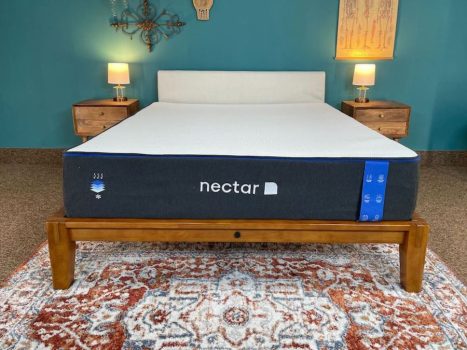
Nectar offers the deeper hug of a traditional memory foam bed but with updated cooling and a Forever warranty.
Material
Foam
Trial Period
365 nights
Shipping Method
Free shipping
Firmness
Medium-firm: 6.5/10
Warranty
Lifetime warranty
Price Range
$$$$$
We recommend this mattress for the following sleeper types:
Joint Pain
This bed is perfect for anyone suffering from joint pain.Hip Pain
This bed is perfect for anyone suffering from hip pain.Back Sleeping
Ideal for lightweight and average weight back sleepers.Side Sleeping
Ideal for lightweight and average weight side sleepers.Financing Options
Financing options are available for this mattress.
Nectar Mattress

Nectar offers the deeper hug of a traditional memory foam bed but with updated cooling and a Forever warranty.
Material
Foam
Warranty
Lifetime warranty
Firmness
Medium-firm: 6.5/10
Shipping Method
Free shipping
Trial Period
365 nights
Price Range
$$$$$
We recommend this mattress for the following sleeper types:
Joint Pain
This bed is perfect for anyone suffering from joint pain.Hip Pain
This bed is perfect for anyone suffering from hip pain.Back Sleeping
Ideal for lightweight and average weight back sleepers.Side Sleeping
Ideal for lightweight and average weight side sleepers.Financing Options
Financing options are available for this mattress.

Nectar Mattress
Nectar offers the deeper hug of a traditional memory foam bed but with updated cooling and a Forever warranty.
Material
Foam
Firmness
Medium-firm: 6.5/10
Trial Period
365 nights
Warranty
Lifetime warranty
Shipping Method
Free shipping
Price Range
$$$$$
We recommend this mattress for the following sleeper types:
Joint Pain
This bed is perfect for anyone suffering from joint pain.Hip Pain
This bed is perfect for anyone suffering from hip pain.Back Sleeping
Ideal for lightweight and average weight back sleepers.Side Sleeping
Ideal for lightweight and average weight side sleepers.Financing Options
Financing options are available for this mattress.
Why the Nectar Earned Best Memory Foam Mattress for Kids
Adults already know the Nectar as a popular memory foam mattress you can order online. After testing it extensively, I recommend it for kids, too—it has a versatile, medium-firm feel with lots of support from its strong base foam. At the same time, its upper two layers give you a nice amount of pressure relief.
As an all-foam mattress, it may be better suited for older children who want a bit more softness and less bounce to their bed.
What’s the Nectar Mattress Made Of?
The Nectar is 12 inches high and has five total layers if you count its top and bottom covers.
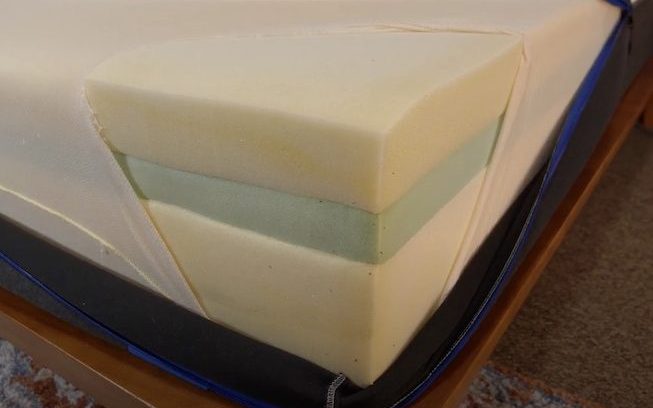
- Layer 1 – Top Cover. A heat-resistant cover made with polyethylene fibers.
- Layer 2 – Gel Memory Foam (2 inches). Gel-infused foam that molds to the contours of your body, cradling your joints.
- Layer 3 – Dynamic Response Foam (3 inches). A firmer foam that responds more quickly than the layer above.
- Layer 4 – ActiveSupoort Foam (7 inches). The robust foam base of the bed.
- Layer 5 – Lower Cover. A polyester cover that holds all the layers of the mattress together.
My Take: I like how the Nectar capitalizes on the cradling feel of memory foam without letting side and back sleepers sink too low. I don’t recommend it for plus-size adults or stomach sleepers, but these drawbacks likely don’t apply to kids, who are smaller.
What I Liked
- Lots of pressure relief – The initial layers of the Nectar felt lovely on my joints. When I was on my side or my back, they had just enough give to feel plush, but they never sank so low that I felt out of alignment.
- Awesome policies – Nectar gives you a full year to try out the bed risk-free, and also offers a lifetime warranty. On top of the mattress’s affordable price, these policies have helped establish them as a trustworthy brand.
Potential Drawbacks
- Heat can build up – Even with cooling components in place, this is an all-foam bed. It’ll be susceptible to heat buildup more than its hybrid counterparts.
- Edges don’t stand out – The Nectar doesn’t have noteworthy edge support, which may be important to you if your child tends to roll toward the side of the bed.
Customer Reviews of the Nectar Mattress
With thousands of reviews on Nectar’s website, the Nectar mattress has an average 4.8 out of 5 stars. One common customer complaint about the Nectar mattress is its longer-than-average break-in period, while many customers praise its excellent value and comfort once fully settled.
Want to know more? Read our in-depth Nectar mattress review, or browse the best memory foam beds.
Birch Natural – Best Organic Mattress for Kids
Birch Natural Mattress
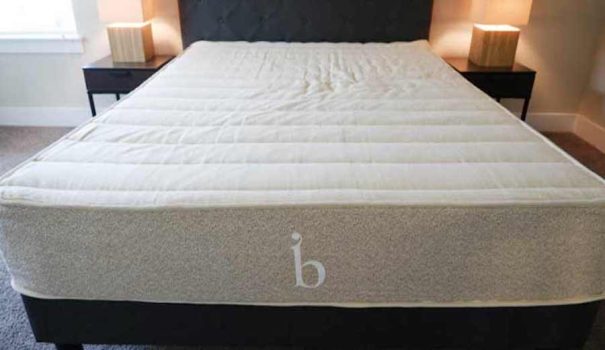
An eco-friendly bed that pairs latex and individually wrapped coils for a versatile hybrid sleep experience.
Material
Hybrid
Trial Period
100 nights
Shipping Method
Free shipping
Firmness
Medium-firm: 6.5/10
Warranty
25-year warranty
Price Range
$$$$$
We recommend this mattress for the following sleeper types:
Hot Sleepers
If you often overheat while you sleep, this mattress should help you stay cool.Back Sleeping
Ideal for average weight back sleepers.Stomach Sleeping
Ideal for average weight stomach sleepers.Financing Options
Financing options are available for this mattress.
Birch Natural Mattress

An eco-friendly bed that pairs latex and individually wrapped coils for a versatile hybrid sleep experience.
Material
Hybrid
Warranty
25-year warranty
Firmness
Medium-firm: 6.5/10
Shipping Method
Free shipping
Trial Period
100 nights
Price Range
$$$$$
We recommend this mattress for the following sleeper types:
Hot Sleepers
If you often overheat while you sleep, this mattress should help you stay cool.Back Sleeping
Ideal for average weight back sleepers.Stomach Sleeping
Ideal for average weight stomach sleepers.Financing Options
Financing options are available for this mattress.

Birch Natural Mattress
An eco-friendly bed that pairs latex and individually wrapped coils for a versatile hybrid sleep experience.
Material
Hybrid
Firmness
Medium-firm: 6.5/10
Trial Period
100 nights
Warranty
25-year warranty
Shipping Method
Free shipping
Price Range
$$$$$
We recommend this mattress for the following sleeper types:
Hot Sleepers
If you often overheat while you sleep, this mattress should help you stay cool.Back Sleeping
Ideal for average weight back sleepers.Stomach Sleeping
Ideal for average weight stomach sleepers.Financing Options
Financing options are available for this mattress.
Why the Birch Natural Earned Best Organic Mattress for Kids
Many parents have valid concerns about the materials going into their child’s mattress. Rather than purchasing a more traditional bed made with largely synthetic foams and fabrics, they may want to invest in an organic mattress.
The Birch Natural is a fantastic eco-friendly find for children. It’s constructed with latex, organic cotton, organic wool, and steel coils. Aside from its earth-minded credentials, it also has a good firmness level for a growing child: medium firm, with lots of responsiveness from the latex and springs.
What’s the Birch Natural Made Of?
The Birch Natural is 11 inches tall and has six layers.
- Layer 1 – Organic Cotton Cover. Made of GOTS-certified organic cotton, this cover feels soft and encourages cooling airflow.
- Layer 2 – Organic Wool. The first layer of wool functions as a natural fire barrier.
- Layer 3 – Organic Wool. The second layer of wool adds cushion and insulating properties to the mattress.
- Layer 4 – Natural Talalay Latex. A hypoallergenic, naturally breathable material, latex combines the pressure relief of traditional foams with a more springy feel.
- Layer 5 – Coils. Individually wrapped springs provide reliable support, and are reinforced lengthwise to brace up the edges.
- Layer 6 – Organic Wool. A final wool layer serves as an additional flame-resistant feature.
Our Take: “The organic cotton cover is soft to the touch, and the wool layers are comfortable and cozy to lie down on … I really appreciate the way the latex and coils respond to my movements, helping me to switch positions easier without feeling stuck in the bed.” – Stuart Petty, Sleep Advisor Mattress Tester
What We Liked
- Certified for safety and eco-friendliness – The Birch Natural boasts several certifications from organizations such as eco-INSTITUT, GREENGUARD Gold, and Global Organic Textile Standard (GOTS). These credentials attest to the safety and sustainability of its materials.
- Beneficial latex layer – Latex is an innately hypoallergenic material, and it runs cooler than memory foam. It should help keep your child’s Birch mattress clear from irritating allergens and germs.
Potential Drawbacks
- Not everyone loves latex – Latex feels slightly different than the foams you might be used to in a bed. It’s more bouncy than memory foam, and it’s quicker to respond, so it won’t have a slow sink to it.
- Cost – As an organic mattress, even a twin-sized Birch will be more expensive than most of the other beds on this list. It’s usually priced between $1,000 and $1,500, depending on active discounts.
Customer Reviews of the Birch Natural
According to Birch’s website, the Birch Natural scores a 4.6 out of 5 stars. While some users consider the Birch Natural mattress to be on the pricier side, it gains customer appreciation for its organic materials and sustainable, eco-friendly construction.
Want to know more? Visit our in-depth Birch Natural mattress review or discover the best organic mattresses.
Other Kid-Friendly Mattresses We Tested
While these mattresses didn’t make our list, each of these beds are great fits for kids to support them as they grow and sleep through the night. Check out our featured recommendations below.
Product
Firmness
Trial Period
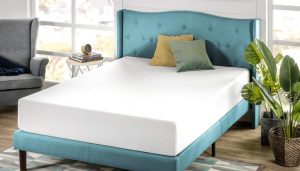
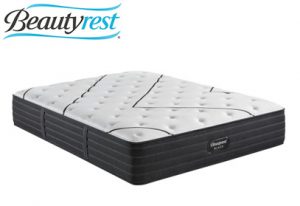
Product
Beautyrest Black MattressFirmness
Firm: 7.5/10Trial Period
100 nights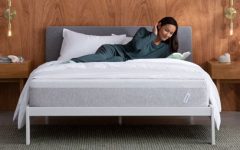
Product
Tuft & Needle MattressFirmness
Medium: 5/10Trial Period
100 nights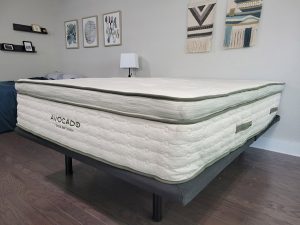
Product
Avocado Green MattressFirmness
Medium-firm: 6.5/10Trial Period
365 nights
Product
Zinus Green Tea Memory Foam MattressFirmness
Medium-firm: 6/10Trial Period
100 nights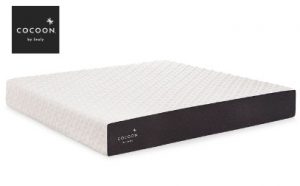
Product
Cocoon Chill MattressFirmness
Medium-firm: 6/10Trial Period
100 nights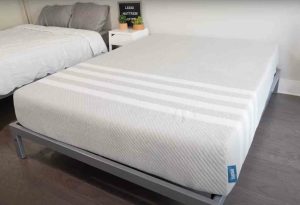
Product
Leesa Original MattressFirmness
Medium: 5.5/10Trial Period
100 nightsChoosing the Best Mattress for a Kid: Key Considerations
When selecting a bed for your child, you’ll want to look at mattresses that provide the right amount of support for a growing kid—and they may look quite different from beds meant for adults.
If your child is old enough to weigh in, ask them what their dream bed looks and feels like. We also recommend ordering a bed with a long sleep trial so they can test it out over time (and you can return it if it’s causing problems). Otherwise, keep the following factors in mind as you shop.
Age and Mattress Size
Your child’s age should help determine the size of the mattress you buy for them. Consult the chart below to compare different mattress sizes, their intended age groups, and their most noteworthy features.
| Size | Dimensions | Age Group | Key Features | Guide |
| Crib | Approx. 28” x 52” | Infants and Toddlers (0-3 years) | * Very firm for essential support * Often dual-sided * Waterproof or water-resistant | Best Crib Mattresses |
| Twin | 38” x 75” | Kids (3-12 Years), Teens, and Adults | * Affordable * Conserves space * Many models designed specifically for kids | Best Twin Mattresses |
| Twin XL | 38” x 80” | Kids (3-12 Years), Teens, and Adults | * Affordable * More comfortable for taller sleepers | Best Twin XL Mattresses |
| Full | 54” x 75” | Kids (3-12 Years), Teens, and Adults | * More space for spreading out * Room for two sleepers | Best Full Mattresses |
Mattress Type
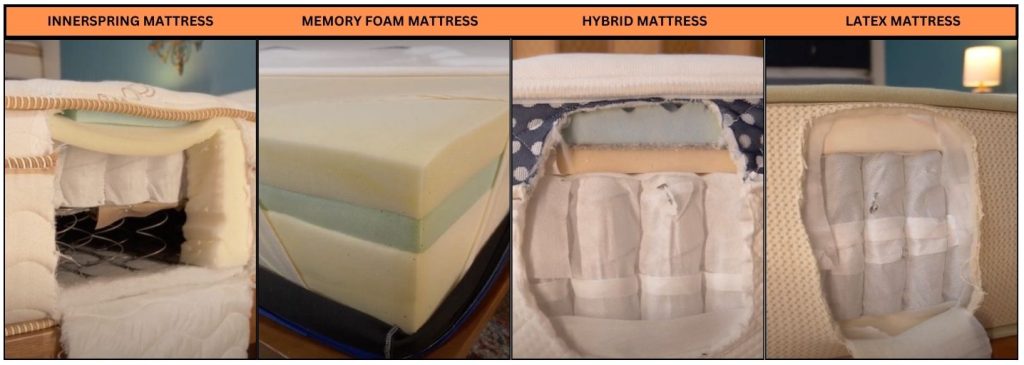
The type of mattress you choose for a child will determine their experience of the bed’s feel and support.
In our opinion, a hybrid mattress is the ideal choice for a kids’ mattress. These beds mix strong support with just enough softness for comfortable nights. They’re also extremely durable, and that’s a plus given that young children tend to put their mattresses through more wear and tear than other age groups.
The biggest drawback of this kind of bed is its cost. A quality hybrid bed for children will probably be priced higher than an all-foam alternative.
We’ve included a mix of hybrids and foam beds in the roundup above, but hybrids have a slight edge—there are 5 of them, compared to 3 foam options. It’s worth noting that all of the beds specifically designed for children are hybrids, too.
Firmness
When browsing mattresses for kids, aim for a medium-firm feel—around a 6.5 or so on our mattress firmness scale. This firmness is a golden middle ground of sorts, and will be optimal for the vast majority of children throughout most of their junior years. Every single bed on the above list has this firmness level (except for the Plank Firm, which is even firmer).
If a bed is too soft, it might feel inviting at first, but it may not have the proper amount of support or pressure distribution for a growing child.
Support
A mattress’s support is correlated with its ability to encourage neutral spinal alignment. Importantly, support and firmness are not the same thing—a mattress’s firmness doesn’t necessarily indicate anything about the strength or effectiveness of its support system.
For children, maintaining healthy spinal alignment is especially important as their bones grow and develop. You’ll want a kids’ mattress with a durable, well-designed support system, whether it’s a strong innerspring unit or a dense foam base. All of the kids’ mattresses above meet this requirement, with a score of at least 4 out of 5 in this category from our rounds of testing.
Cooling and Breathability
If your child gets too warm while sleeping, they may wake up multiple times throughout the night—a scenario that affects them and their parents. You’ll want a mattress that doesn’t retain too much heat.
Beds with springs foster more airflow than all-foam models, so again, we recommend hybrid beds for children to up the cooling factor. Some beds also have cooling components inside their foam layers (like gel, copper, or graphite infusions), and breathable covers made of textiles such as cotton or Tencel™.
As part of our testing process, we see how well mattresses regulate their temperature after several minutes of someone lying on the bed’s surface. The Saatva Youth and Helix Kids are the best of the bunch—we awarded them both a 4 out of 5 in this category.
Waterproof or Water-Resistant Components
Spills and accidents are all but guaranteed as your child goes through potty training (or sneaks snacks into bed). Some children’s mattresses—including the Saatva Youth and Helix Kids—are built with water-resistant or waterproof covers or barriers to help make cleanup easier.
As you shop for a kids’ mattress, pay attention to any waterproof or water-resistant components that will add to the bed’s convenience factor. If your heart is set on a kids’ mattress without these features, you can also investigate mattress protectors that you’d purchase separately.
See our favorites here: Best Mattress Protectors
Ease of Cleaning
Whether or not your child’s mattress has any waterproof elements, it should be easy to clean when accidents occur.
Some of the mattresses above stay clean via spill-resistant covers and antimicrobial treatments. Others, such as the Puffy Cloud, have a cover that can be unzipped and washed.
The Nectar, Plank, Bear Cub, and Birch Natural don’t have any built-in components that help with cleaning, but can be spot cleaned as well as shielded by a removable mattress protector.
Materials, Certifications, & Safety
As you think about which kids’ mattress to buy, you’ll want to look out for beds with safe, premium materials and certifications from reputable third-party organizations. If a manufacturer uses vague language around its mattresses’ constructions, or only includes scant details about the materials that go into its beds, you should be wary.
If shopping organically is important to you, keep an eye out for certifications from GOTS (Global Organic Textile Standard) and GOLS (Global Organic Latex Standard).
Other mattress certifications that signal a lack of potentially harmful chemicals and low emissions include those from CertiPUR-US®, UL GREENGUARD, MADE SAFE®, and more. Some companies will also put kids’ mattresses through testing for substances such as phthalates and lead. Always try to trace these testing claims to a trustworthy and findable source.
On this list, every mattress has CertiPUR-US® certification at the very least. The Saatva Youth, Helix Kids, Bear Cub, and Birch Natural lead the way in additional certifications and safety credentials.
Hypoallergenic Mattresses for Children
If you’re concerned about your child’s susceptibility to allergens, look for beds with materials that resist the accumulation of common ones. Latex, for example, can resist the buildup of dust mites and other irritants.
Other mattresses may be protected from allergens and germs by antimicrobial treatments, or innately antimicrobial substances such as copper or wool.
Note: the term “hypoallergenic” doesn’t have any official certifications associated with it, so it’s often bandied about by mattress companies. Be sure to research whether or not an allegedly hypoallergenic mattress has components that will actually guard against your child’s allergens.
Brand Reputation
A reputable mattress brand sells durable, high-quality beds and honors the promises it makes to its customers. Finding a brand you can trust is of the utmost importance as you plan out your child’s bedroom.
We’ve vetted the brands on this list and tested multiple mattresses from each of them to ensure that their products match their advertising. We also take warranties, sleep trials, and other policies into account when deciding which beds to highlight. When possible, we also get in touch with the brand’s customer service to gauge how quickly and efficiently they can address questions and feedback.
Why Is a High-Quality Kids’ Mattress So Important?
As children grow and develop, they need regular, deep, and restful sleep. A mattress that suits their body’s needs and their comfort preferences is therefore essential.
In fact, not getting enough sleep as a child is correlated with worrisome health and behavioral outcomes.
What Happens If Children Don’t Get Enough Sleep?
A substantial body of research proves that a lack of sleep at a young age can lead to a variety of physical and mental issues, including:
- Diabetes
- Hypertension
- Obesity
- Stress
- Depression
- Anxiety
- Impaired memory and learning1
A 2022 study even found that insufficient sleep led to visible changes in brain structure for 9- and 10-year-olds. Specifically, regions that govern attention, memory, and impulsivity had “less grey matter or smaller volume” than those in children who were getting nine or more hours of sleep per night.2
Longitudinal studies also suggest that disrupted or low-quality sleep in childhood can have long-term effects, including a higher likelihood of depression, anxiety, or behavior issues later in life.3
How Much Sleep Do Kids Need?
How much sleep a child needs depends on their exact age. In 2016, the American Academy of Sleep Medicine published their guidelines for each age group1:
| Child’s Age | Recommended Amount of Sleep per Night |
| 4 to 12 Months | 12 to 16 Hours |
| 1 to 2 Years | 11 to 14 Hours |
| 3 to 5 Years | 10 to 13 Hours |
| 6 to 12 Years | 9 to 12 Hours |
| 13 to 18 Years | 8 to 10 Hours |
Distressingly, in 2021 CDC reported that more than a third of children in the United States were not getting the recommended amount of sleep.4
Best Beds for Kids FAQs
Are memory foam mattresses good for kids?
A memory foam mattress may be a good fit for your child’s needs if it’s not too soft. If you want an all-foam kids’ bed, pick one that’s medium-firm rather than plush.
However, a mattress with springs will generally outlast an all-foam bed and have a stronger support unit. That’s why we recommend hybrid beds (which have both springs and foam comfort layers) for children.
How firm should a child’s mattress be?
A kid’s mattress should be medium-firm or firm, rather than soft. This firmness level accommodates the widest range of sleeping positions and helps to promote a neutral spinal alignment as your child grows.
How tall should a kid’s mattress be?
A child’s mattress should be at least 6 inches tall, though around 8 inches is preferable. Kids don’t need the same amount of height from their beds as adults do, so the mattresses on our list above are all between 8 and 12 inches thick.
How do you clean pee out of a mattress?
Cleaning urine from a mattress after your child has an accident is a multi-step process, but it’s very doable and only requires a few household items.
- Put any soiled bedding into the washing machine as soon as you discover the accident.
- Use paper towels or rags to blot the affected area. Don’t try to scrub the urine out, just apply and release pressure to absorb excess moisture.
- Spray the area with a solution made of white vinegar and water. Most sources recommend a half-and-half mixture. You can also add a couple tablespoons of detergent to either the spray bottle or the mattress itself (before you spray).
- After thoroughly spraying the spot, layer baking soda on top of it. Use a generous amount, so the area is fully covered. Let the baking soda sit for 8 hours or more.
- Vacuum up the baking soda. If odors or stains are lingering, you can repeat steps 3 through 5 as needed.
Recap: The Best Mattresses for Kids
| Mattress | Best For | Price (Full Size) | Review |
| Helix Kids | Editor’s Pick | $899.00 | Helix Kids Mattress Review |
| Saatva Youth | Innerspring | $999.00 | Saatva Youth Mattress Review |
| Puffy Cloud | Medium-Firm | $1,099.00 | Puffy Cloud Mattress Review |
| Plank Firm | Firm | $949.00 | Plank Firm Mattress Review |
| Bear Cub | Hybrid | $845 | Pending |
| Brooklyn Bedding Brooklyn Essential | Affordable | $799.00 | Brooklyn Essential Mattress Review |
| Nectar | Memory Foam | $899.00 | Nectar Mattress Review |
| Birch Natural | Organic | $1,599.00 | Birch Natural Mattress Review |

Julia Forbes
Lead Product Tester
About Author
Julia is the Lead Reviewer at Sleep Advisor, specializing in testing out mattresses and sleep accessories – she’s in the right line of work, because she loves to sleep.
Stomach Sleeper
References:
- Paruthi, Shalini et al. “Consensus Statement of the American Academy of Sleep Medicine on the Recommended Amount of Sleep for Healthy Children: Methodology and Discussion”. Journal of Clinical Sleep Medicine. November 2016.
- Contie, Vicki. “Children’s sleep linked to brain development”. National Institutes of Health. Last modified August 30, 2022.
- Alrousan, Ghalya, Hassan, Arham, Anilkumar Pillai, Aditya, Atrooz, Fatin, & Salim, Samina. “Early Life Sleep Deprivation and Brain Development: Insights From Human and Animal Studies”. Frontiers in Neuroscience. May 2022.
- Wheaton, Anne G., & Claussen, Angelika H. “Short Sleep Duration Among Infants, Children, and Adolescents Aged 4 Months–17 Years — United States, 2016–2018”. Centers for Disease Control and Prevention Morbidity and Mortality Weekly Report. September 2021.
